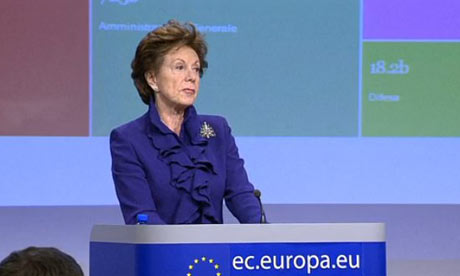Wednesday, December 14, 2011
The Guardian Datablog: The best way to get value from data is to give it away
The best way to get value from data is to give it away
Yesterday European Vice President Neelie Kroes unveiled a new package of policies related to open data and public sector information

Neelie Kroes making EC open data announcement from okfn on Flickr Photograph: Guardian
Last Friday I wrote a short piece on for the Datablog giving some background and context for a big open data big policy package that was announced yesterday morning by Vice President Neelie Kroes. But what does the package contain? And what might the new measures mean for the future of open data in Europe?
The announcement contained some very strong language in support of open data. Open data is the new gold, the fertile soil out of which a new generation of applications and services will grow. In a networked age, we all depend on data, and opening it up is the best way to realise its value, to maximise its potential.
There was little ambiguity about the Commissioner's support for an 'open by default' position for public sector information, nor for her support for the open data movement, for "those of us who believe that the best way to get value from data is to give it away". There were props to Web Inventor Tim Berners-Lee, the Open Knowledge Foundation,OpenSpending, WheelMap, and the Guardian Datablog, amongst others.
But will Brussels walk the walk? What is actually in the package? Two very concrete, more or less straightforward things topped the bill: data and cash. Firstly, the European Commission will lead the way by pioneering open data policies and practises that it would like to see adopted by EU member states. "Eating your own dogfood", as software developers affectionately call it. They will open up documents and datasets from across dozens of institutions - no mean feat, as I'm sure UK Government representatives will have told Neelie when she and her team visited Number 10 earlier this year.
Secondly the Commission will put up €100 million in financial support for research into "data-handling technologies". This will no doubt stimulate cross-border collaboration around tools and technologies that will enable more people, projects, organisations and companies to derive value from data. Hopefully some of this will support some of the wonderful work that is already going on to clean up, harmonise, and expose data to the public - as well as funding the creation of more easy to use open source tools and applications that consume it to help us do more useful things and answer more sophisticated questions.
Tuesday, December 13, 2011
Google Public Data Explorer 2.0: Making Public Data More Accessible on the Web
Making Public Data More Accessible on the Web
12/12/11 | 11:00:00 AM
Last year, we launched the Google Public Data Explorer, an online tool that organizes public statistics and brings them to life with interactive exploration and visualizations. Since then, we’ve added dozens of new datasets and received enthusiastic feedback from users around the world. Several data providers, such as the UN Development Programme and Statistics Catalunya, have even integrated the tool into their web sites.
Today, we’re pleased to announce the next step in our public data effort- a completely revamped product featuring an updated look and feel, improved interaction modes, and a new visualization engine.
Now you can:
1. Search across the data
Our most popular datasets have been accessible through Google Web Search for some time, and this will continue to be the case. Now, however, you can also search within the product, across our extensive corpus of public statistics. This allows you to find data on issues such as global competitiveness, population density, or infant deaths. The search page also features a set of sample visualizations and stories, which highlight some of the topics covered by the product.
2. Slice and dice with fewer clicks
Once you’ve selected a dataset, the new exploration UI puts the data front and center. Want to plot “Fertility Rate” instead of “GDP”? Just make a single click in the list to the left of the chart. Interested in the unemployment rate for women as opposed to men? Just as easy. No more digging through pop-ups or settings menus.
3. Access it on any device
Our new charts are built according to open web standards such as HTML5. As a result, they work across all common desktop, tablet, and smartphone configurations, without depending on third-party plugins. We expect the performance and functionality of the charts to improve over time as browser support for HTML5 matures.
Give the new Google Public Data a try, and let us know what you think by posting in our discussion forum.
Posted by Benjamin Yolken, Product Manager, Google Public Data Team
Today, we’re pleased to announce the next step in our public data effort- a completely revamped product featuring an updated look and feel, improved interaction modes, and a new visualization engine.
Now you can:
1. Search across the data
Our most popular datasets have been accessible through Google Web Search for some time, and this will continue to be the case. Now, however, you can also search within the product, across our extensive corpus of public statistics. This allows you to find data on issues such as global competitiveness, population density, or infant deaths. The search page also features a set of sample visualizations and stories, which highlight some of the topics covered by the product.
2. Slice and dice with fewer clicks
Once you’ve selected a dataset, the new exploration UI puts the data front and center. Want to plot “Fertility Rate” instead of “GDP”? Just make a single click in the list to the left of the chart. Interested in the unemployment rate for women as opposed to men? Just as easy. No more digging through pop-ups or settings menus.
3. Access it on any device
Our new charts are built according to open web standards such as HTML5. As a result, they work across all common desktop, tablet, and smartphone configurations, without depending on third-party plugins. We expect the performance and functionality of the charts to improve over time as browser support for HTML5 matures.
Give the new Google Public Data a try, and let us know what you think by posting in our discussion forum.
Posted by Benjamin Yolken, Product Manager, Google Public Data Team
Monday, December 12, 2011
EUROPA - Press Releases - Digital Agenda: Turning government data into gold
EUROPA - Press Releases - Digital Agenda: Turning government data into gold
Brussels, 12 December 2011 – The Commission has launched an Open Data Strategy for Europe, which is expected to deliver a €40 billion boost to the EU's economy each year. Europe’s public administrations are sitting on a goldmine of unrealised economic potential: the large volumes of information collected by numerous public authorities and services. Member States such as the United Kingdom and France are already demonstrating this value. The strategy to lift performance EU-wide is three-fold: firstly the Commission will lead by example, opening its vaults of information to the public for free through a new data portal. Secondly, a level playing field for open data across the EU will be established. Finally, these new measures are backed by the €100 million which will be granted in 2011-2013 to fund research into improved data-handling technologies.
Friday, December 9, 2011
The Guardian Datablog: Opening Europe's Data
Opening Europe's Data
The European Commission is set to make a major announcement about the future of the Public Sector Information Directive on Monday. Jonathan Gray from the Open Knowledge Foundation discusses what this might mean for open data in Europe
- Jonathan Gray
- guardian.co.uk,
- Article history

opening europe's data Photograph: guardian.co.uk
Approximately one in fourteen people on the planet now live in one of Europe's 27 Member States. There are thousands of local, regional and central government bodies in Europe, which collectively disburse billions and billions of euros on behalf of European citizens every year (over€6,182bn in 2010).
Many of these public bodies collect or generate information relevant to their operations - from the timetables of trains or rubbish collection services, to metrics on schools, universities and hospitals, to databases on carbon emissions, weather patterns, or biodiversity. "How much data?" asks a distant, data-hungry cry. While I'm not sure that this is something that any statistics department has got around to measuring nor something that has yet been subjected to brazen guesstimation, I think it's fairly safe to say: lots and lots.
Much of this data is, of course, private information about citizens, and hence should be handled like Plutonium pellets ("Kept in secure containers, handled as seldom as possible and escorted whenever it has to travel"). And some of it shouldn't see the light of day on national security grounds (at least for a while). But much of it is or should be public: free for all to access, use and benefit from. The information that public bodies collect and use for themselves are often relevant to us.
Subscribe to:
Posts (Atom)